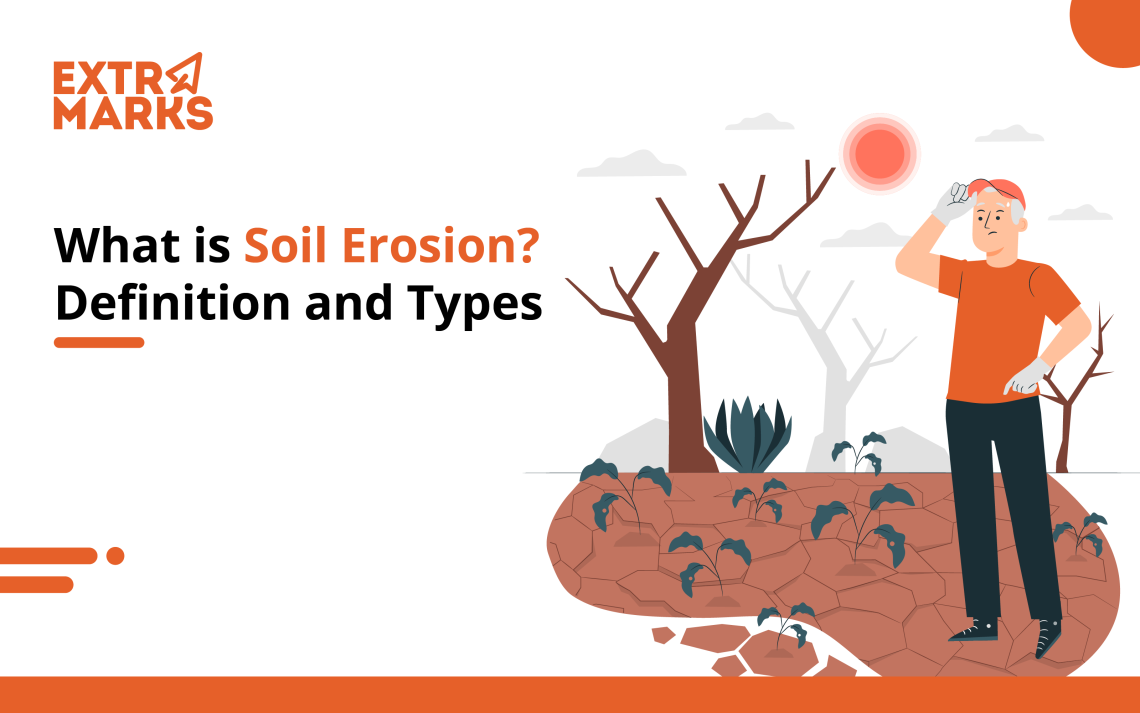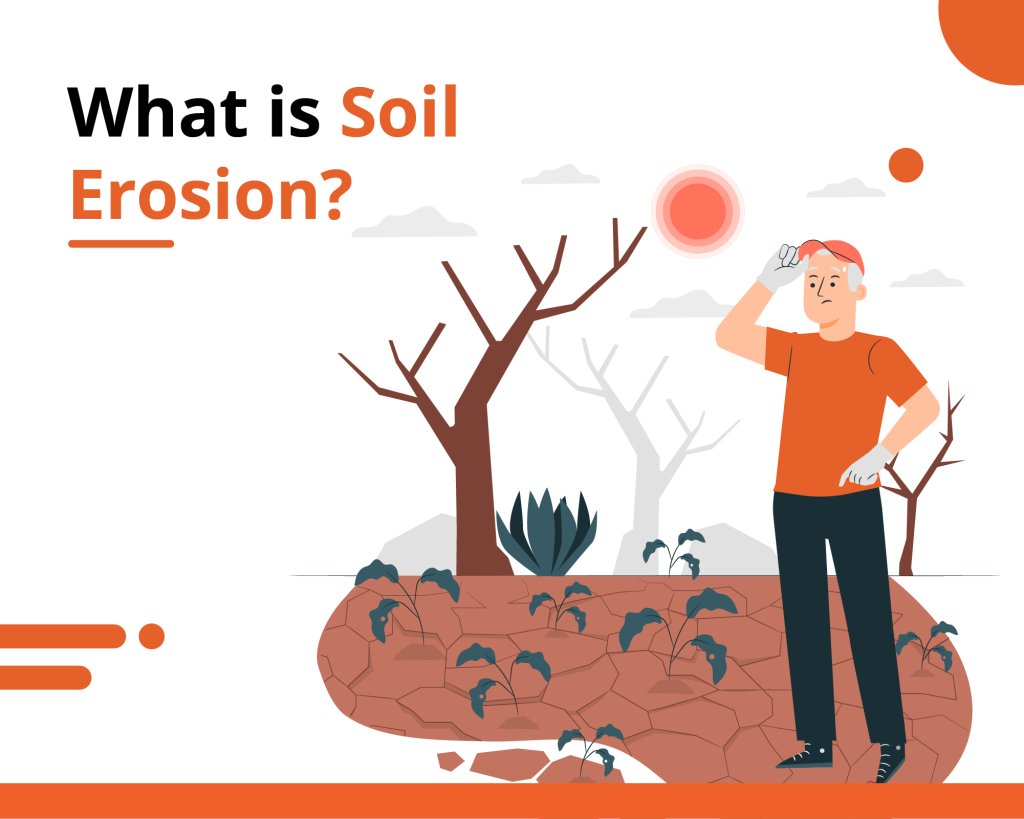What is Soil Erosion? Definition and Types

Soil erosion is the loss of soil from a land’s surface as a result of natural processes or human activity. The rate and extent of soil erosion can be measured by examining changes in soil depth, loss of protective vegetation, and water-erosion gullies.
The most common form of soil erosion is caused by rainwater falling on the unprotected ground and eroding the bare Earth at rates that vary depending upon the intensity and duration of rainfall. In this blog, we will tell you what is soil erosion, the types of soil erosion, and much more.
What Are The Different Types Of Soil Erosion?

Following are the different types of soil erosion:
1. Splash Erosion
Splash erosion or raindrop impact represents the first stage in the erosion process. Splash erosion results from the bombardment of the soil surface by raindrops. Raindrops behave as little bombs when falling on exposed or bare soil, displacing soil particles and destroying soil structure. Studies in America have shown that splashed particles may rise as high as 0.6 meters above the ground and move up to 1.5 meters horizontally. Splash erosion results in the formation of surface crusts which reduce infiltration resulting in the start of runoff.
2. Sheet Erosion
This is among the most common types of soil erosion and occurs as a result of rainfall. The water flows downslope, displacing soil particles in its path by means of gravitational force and adhesion to other particles. This form of erosion is associated with droughts and heavy rainfall events.
Sheet erosion is the most common form of soil erosion. Sheet erosion occurs as a result of rainfall, in which water flows downslope and displaces soil particles by means of gravitational force adhesion to other particles. This type of erosion can be associated with droughts or heavy rain events. In sheet formation, the water flows perpendicular to the slope. And, there is erosion on both sides of the stream channel and a net loss in soil mass from that area.
3. Gully Erosion
This form of erosion occurs when the water flows in a gully or gulch, which is an eroded side channel. Gullies are formed by running water that has accumulated from rain and snowmelt on slopes with little protection from vegetation cover. Gully erosion impacts both sides of the channel for a net loss greater than any other type of erosion.
Gullies have V or U shapes and are steeper the greater they are. It occurs on slopes with little protection from vegetation cover, where there’s no runoff control from rainwater or snowmelt. This form of soil erosion builds up the channel with deposits from its bed, which can lead to gullies widening and deepening.
4. Rill Erosion
Rill erosion is the wearing down of soil by the small channels, or rolls, that form when rainwater flows across bare ground. Rilled soils are more susceptible to wind erosion and water erosion than non-rill eroded ones, which makes them vulnerable to loss of topsoil. A major cause of rill erosion is the wearing down of farmland and open rangelands by cattle, sheep, goats, or other grazing animals.
These animals make deep cuts in the soil surface to get at grasses on the lower level. When they pull back their heads up after each bite, a cut is formed that causes rainwater to run off the field, carrying soil with it. Rill erosion typically begins with runoff from rainstorms, which erodes the topsoil and affects soil fertility. It is a largely irreversible process that can cause the land to become unsuitable for farming or reforestation because of increased susceptibility to wind erosion.
What Are The Causes Of Soil Erosion?
Soil erosion is a natural process, but it’s triggered by man. In this article, we’ll be focusing on three major causes of different types of soil erosion:
1. Plowing without crop rotation is a common cause for erosion as plows turn over the fertile top layer, exposing crops to heavy rains, which wash away the nutrients. This exposes more and more of the Earth’s surface to the water, which leads to erosion by wind and rain.
2. Overgrazing livestock can lead to extensive soil loss if overuse is left unchecked. Overgrazed land has little vegetation that protects it from heavy rains, leading to runoff carrying away topsoil in streams and rivers. The erosive forces of wind often deposit this topsoil in other places, leading to more erosion elsewhere.
3. Building on bare dirt can lead to soil loss as the water that passes through it washes away its nutrients. This leads to increased amounts of soil being washed downstream or blown by winds into nearby fields, increasing erosion.
Effects Of Soil Erosion
Soil erosion affects the whole ecosystem. It leads to less productive soil, which in turn threatens human populations with starvation as crops become infertile and fewer people are able to grow food for themselves.
It also destroys wildlife habitat that provides homes for many animals who live on Earth today. And it can lead to sinkholes or landslides if the soil becomes too weak to support the weight of buildings and other structures built on it.
Agricultural experts estimate a loss of more than 5 billion tonnes of soil through water and wind erosion in India every year. Destruction of vegetation is the main cause of soil erosion in outer Himalayas (Shiwaliks). Erosion is widespread particularly on the banks of Yamuna, Chambal, Mahi, and Sabarmati. Soil conservation is an effort by human beings to prevent soil erosion or at least reduce the rate of erosion.
In short, erosion is a natural process that has many causes and effects. The good news? It can be addressed through changes in farming practices. And it is important to address different types of soil erosion to mitigate the implications as much as possible.
Different measures to prevent soil erosion
There are different measures to prevent soil erosion.
1. Afforestation
2. Restricted grazing
3. Proper farming techniques
4. Plugging of gullies
5. Planting of shelter beds
Integrated water and shed management program was launched by the Centre during the Sixth Five Year Plan. It aims at enhancing the ability of catchment of eight flood-prone rivers of the Ganga basin.
Madhya Pradesh, Uttar Pradesh, Rajasthan, and Gujarat adopted the Reclamation and Development of Ravine Areas Programme in 1987-88. The north-eastern states have adopted this program for settling families practicing shifting cultivation.
Frequently Asked Questions
1. What are the negative effects of soil erosion?
These effects of soil erosion include loss of structure of the soil, soil salinity, and nutrient degradation.
2. What are the causes of soil erosion?
Some of the leading causes of soil erosion include water wind, deforestation, overgrazing, crop rotation, terrace farming, etc.
3. How does soil erosion impact humans?
Due to soil erosion, the dust in the environment increases significantly. The dust acts as an air pollutant and abrasive. It also carries approximately 20 human infectious disease organisms.
Last Updated on November 25, 2024








